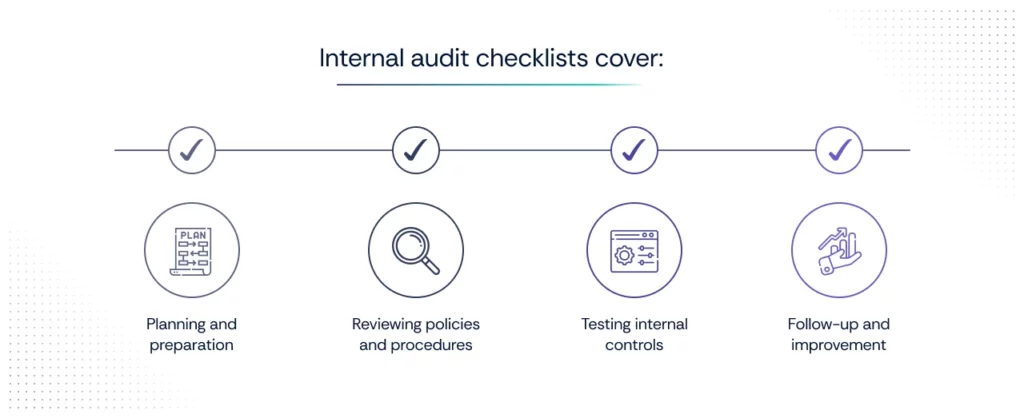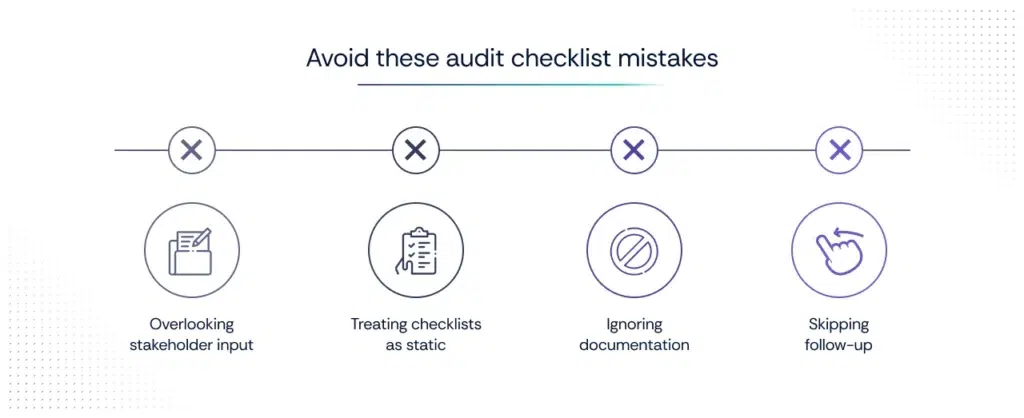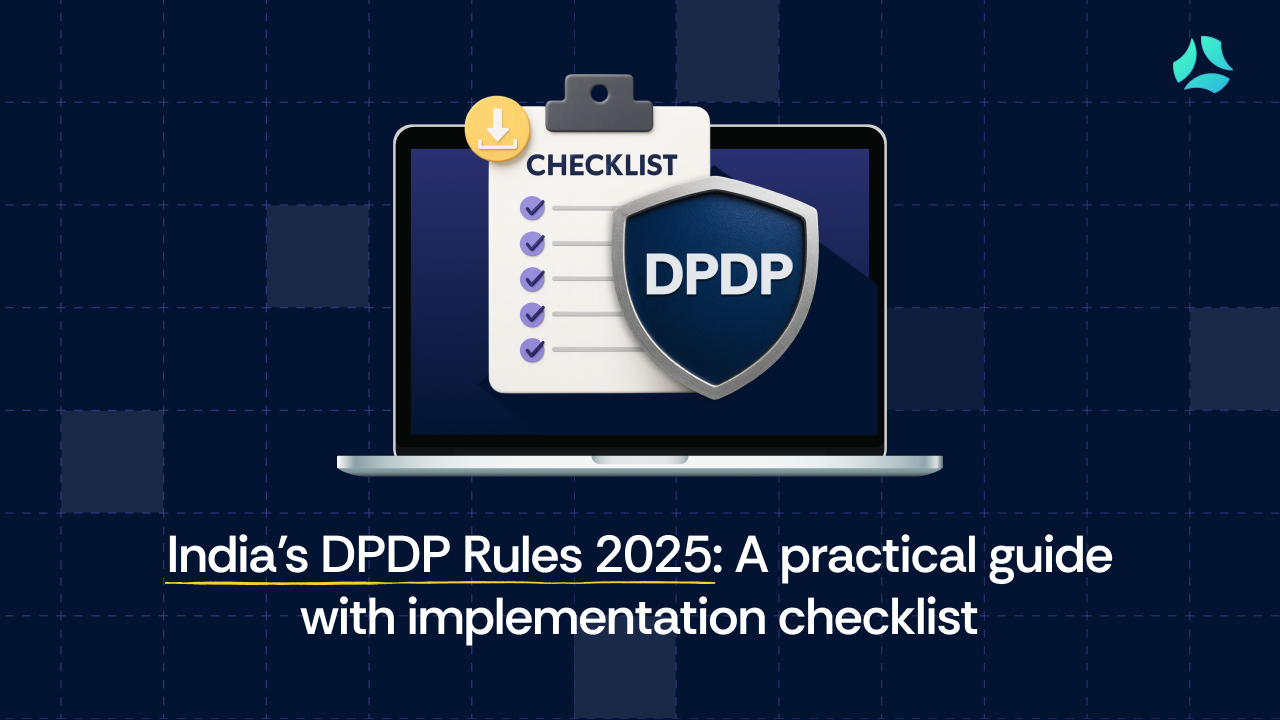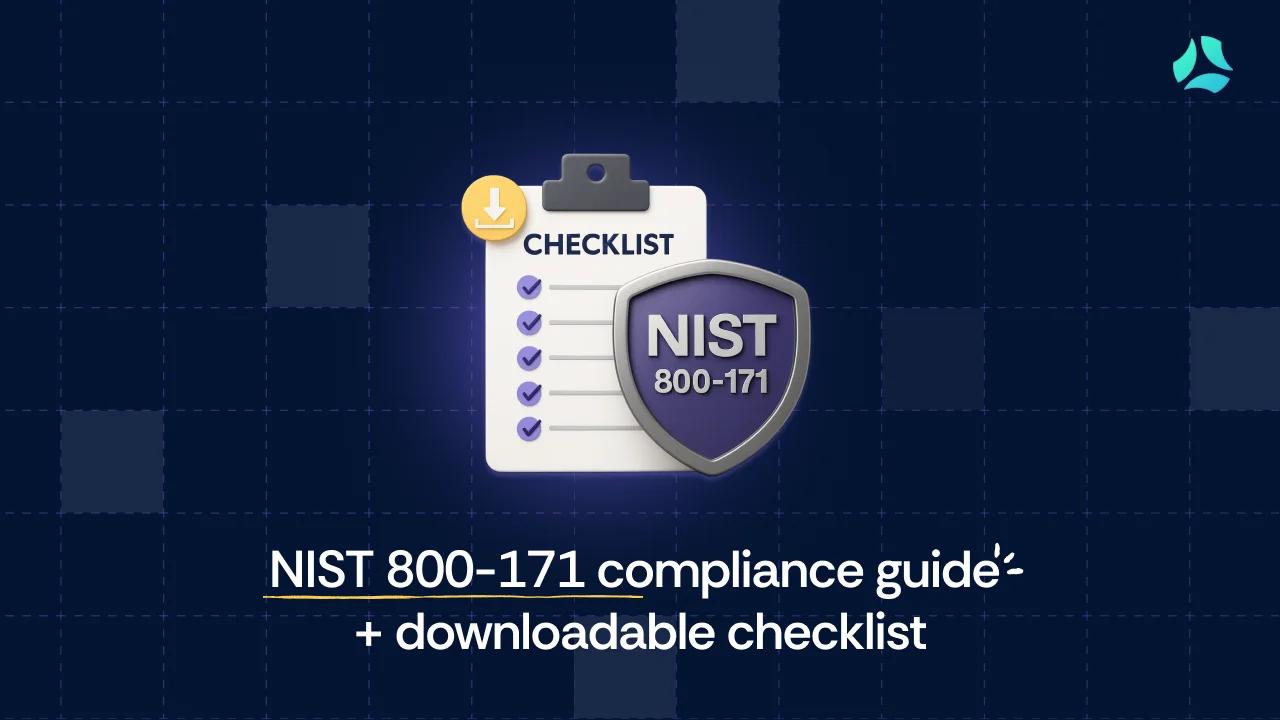Comprehensive Internal Audit Checklist Guide

When it comes to staying compliant and managing risks, internal audits are the unsung heroes of cybersecurity. These proactive assessments identify process inefficiencies, security gaps, and control failures long before external auditors arrive, saving organizations from costly compliance failures.
Specifically, cybersecurity compliance internal audits focus on aligning with standards and regulations like SOC 2, ISO/IEC 27001, NIST CSF, GDPR, and PCI DSS, unlike financial, corporate, or ESG audits, which serve distinct purposes.
However, managing these audits without the right tools can be overwhelming. A well-organized internal audit checklist is essential to streamline the process and ensure compliance. In this blog, we’ll explore the key elements of an effective internal audit checklist and why it’s critical for safeguarding your organization.
What is an Internal Audit?
According to the Institute of Internal Auditors (IIA), an internal audit is “an independent, objective assurance and consulting activity designed to add value and improve an organization’s operations.”
It evaluates governance, risk management, and controls to ensure compliance with standards like SOC 2, ISO/IEC 27001, HIPAA, ISO 9001:2015, and ISO 13485, reviewing cybersecurity measures (e.g., access controls, incident response) and operational efficiency.
Conducted quarterly, annually, or ad-hoc based on risks or regulations, audits involve the audit committee, senior management, and board, with internal auditors reporting to them for independence.
External auditors may provide expertise for complex frameworks, promoting transparency and continuous improvement.
What is an Internal Audit Checklist?
An internal audit checklist is a critical tool that ensures organizations comply with regulations, industry standards, and internal policies. Tailored to specific frameworks like SOC 2, ISO/IEC 27001, or NIST CSF, it serves as a detailed guide for auditors to systematically verify compliance, identify gaps, and prioritize high-risk areas. This risk-based approach, aligned with the Institute of Internal Auditors (IIA) standards, ensures that critical vulnerabilities are addressed first, keeping the audit focused and effective.
Key components include:

- Planning and preparation
- Reviewing policies and procedures
- Testing internal controls
- Follow-up and improvement
What is the Internal Audit Process?
The internal audit process is a structured method to ensure organizations comply with regulations, manage risks, and maintain robust controls, aligned with standards like SOC 2, ISO/IEC 27001, HIPAA, ISO 9001:2015, and ISO 13485. Guided by Institute of Internal Auditors (IIA) standards, it delivers trusted insights to stakeholders (e.g., audit committee) through a risk-based audit schedule, identifying issues and driving continuous improvement in governance and compliance.
5 steps involved in the internal audit process
The internal audit process follows five steps to ensure compliance with standards like SOC 2, ISO/IEC 27001, HIPAA, ISO 9001:2015, and ISO 13485, with stakeholder engagement fostering transparency, per Institute of Internal Auditors (IIA) guidelines.
Step 1: Pre-audit planning
Engage stakeholders (e.g., audit committee) to define scope (e.g., SOC 2 controls, ISO 9001:2015 processes) using an audit preparation checklist. Gather documents (e.g., compliance policies, ISO/IEC 27001 reports), identify high-risk areas, and assemble an independent audit team. This ensures a focused, risk-based audit start.
Step 2: Auditor selection and briefing
Select independent, skilled auditors versed in standards (e.g., HIPAA, ISO 13485). Stakeholders brief the team on objectives and scope, using an audit readiness checklist to ensure resource access. Auditors confirm understanding of the regulatory landscape (e.g., ISO/IEC 27001 requirements).
Step 3: Audit execution
Review policies against a policy audit checklist (e.g., ISO/IEC 27001 alignment), test controls (e.g., SOC 2 MFA, ISO 13485 validation), and collect evidence via interviews and observations. Focus on high-risk areas to uncover compliance gaps with precision.
Step 4: Analysis and reporting
Synthesize findings, identifying risks (e.g., HIPAA safeguard gaps). Draft an actionable report, reviewed with an internal audit quality assurance checklist, and share with stakeholders (e.g., management). The report outlines recommendations to drive compliance improvements.
Step 5: Remediation and follow-up
Implement recommendations, with stakeholders overseeing progress. Conduct internal quality audits to verify corrective actions (e.g., ISO 9001:2015 improvements), scheduling future audits. This closes the audit loop, ensuring ongoing compliance.
Internal vs External Audits
Which audit process is better: Internal or external?
For organizations seeking regular, proactive oversight of compliance and internal controls, the internal audit process is often the better choice.
Conducted by in-house or outsourced auditors familiar with the company’s operations, internal audits focus on improving governance, risk management, and controls, serving internal stakeholders like management and audit committees.
They’re cost-effective, allow frequent reviews, and provide tailored insights for cybersecurity controls like those in SOC 2 or ISO/IEC 27001, fostering continuous improvement.
However, external audits are critical for impartiality and regulatory mandates. Performed by independent third-party auditors, they focus on validating financial statements and compliance for external stakeholders, such as regulators, investors, or clients, and are required for standards like Sarbanes-Oxley (SOX).
SOX mandates both external financial audits and internal control reporting, supported by internal audits assessing controls, often including cybersecurity measures like IT access controls. Internal and external audits serve distinct purposes but are not mutually exclusive; they complement each other, combining proactive oversight with independent validation to ensure robust compliance and credibility. For a deeper dive, check out our guide on Internal vs External Audit.
What are some framework-specific audit checklists?
Organizations use audit checklists to meet compliance standards like SOC 2, ISO/IEC 27001, HIPAA, ISO 9001:2015, and ISO 13485, ensuring regulatory and client requirements are met. Stakeholders, such as the audit committee and management, help prioritize frameworks and create a consolidated checklist with targeted controls, processes, and documentation.
This risk-based approach, aligned with Institute of Internal Auditors (IIA) guidelines, promotes compliance and improvement. Below are key framework-specific checklists, focusing on cybersecurity standards central to compliance, followed by quality management, and a downloadable checklist with sample checkpoints for information security, HR/operations, and finance audits.
Framework-specific audit checklists
These frameworks define compliance requirements, with internal audits—overseen by stakeholders—verifying adherence through targeted controls, processes, and documentation:
1. ISO/IEC 27001 audit checklist
- Controls: Access controls, cryptography, incident response.
- Processes: Risk assessments, ISMS maintenance.
- Documentation: Security policies, risk treatment plans.
- Audit Requirement: Clause 9.2 mandates internal audits to verify ISMS effectiveness, reviewed by management.
2. SOC 2 audit checklist
- Controls: Security (e.g., multi-factor authentication), availability, confidentiality.
- Processes: Control monitoring, gap remediation.
- Documentation: Control descriptions, evidence logs.
- Audit Requirement: Internal audits support Trust Services Criteria compliance, with audit committee oversight.
3. HIPAA audit checklist
- Controls: Administrative, technical, physical safeguards.
- Processes: Risk analysis, breach notification.
- Documentation: Security policies, risk assessment reports.
- Audit Requirement: Audits ensure Privacy and Security Rule compliance, approved by stakeholders.
4. ISO 9001:2015 audit checklist
- Controls: Leadership engagement, operational controls.
- Processes: Planning, continual improvement.
- Documentation: Quality policies, process records.
- Audit Requirement: Clause 9.2 requires internal audits to ensure quality processes, supporting cybersecurity (e.g., secure vendor management), with management review.
5. ISO 13485 audit checklist
- Controls: Management responsibility, product realization controls.
- Processes: Resource management, measurement.
- Documentation: QMS policies, device compliance records.
- Audit Requirement: Clause 8.2.4 mandates internal audits for medical device quality, complementing cybersecurity (e.g., secure device software), with stakeholder oversight.
Common mistakes to avoid when using audit checklists
Using audit checklists for frameworks like SOC 2, ISO/IEC 27001, HIPAA, ISO 9001:2015, or ISO 13485 requires precision to ensure compliance. Avoid these common mistakes:

1. Overlooking stakeholder input: Failing to engage the audit committee or management (e.g., for SOC 2 scope definition) risks misaligned priorities.
2. Treating checklists as static: Not tailoring checklists to specific controls (e.g., ISO 27001 A.5.1.1 policies, ISO 13485 device validation) can miss critical risks.
3. Ignoring documentation: Incomplete records (e.g., HIPAA risk assessments, ISO 9001:2015 quality logs) undermine audit evidence.
4. Skipping follow-up: Not addressing non-compliance (e.g., weak MFA in SOC 2, quality gaps in ISO 9001:2015) delays corrective actions.
Making internal audits smarter with automation
As organizations grow, audits get more complex. More controls, more stakeholders, more documentation—and less time. Running internal audits manually across spreadsheets, email threads, and disconnected systems isn’t just inefficient. It’s risky.
That’s why audit teams are increasingly turning to automation.
Internal audit automation isn’t about replacing human judgment. It’s about making audits more effective, consistent, and less disruptive. Automating control testing, evidence collection, policy tracking, and audit workflows helps teams stay focused on what really matters: identifying risks, closing gaps, and driving accountability across the business.
That’s exactly where Scrut fits in.
Scrut automates the most painful parts of the internal audit process. It connects to your cloud infrastructure, HR, and IT systems to pull real-time evidence across controls—whether you’re working toward ISO 27001, SOC 2, HIPAA, or all of the above. It maps your existing controls to multiple frameworks, flags misconfigurations, and even assigns tasks to the right owners so nothing falls through the cracks.
Auditors get version-controlled logs, centralized documentation, and built-in collaboration tools to resolve findings faster. And when it’s time to report, Scrut gives you a complete audit trail—clean, audit-ready, and backed by live data.
The bottom line? Internal audits don’t have to be a quarterly scramble. With the right automation in place, they can become a strategic rhythm—built into how your team works every day.

FAQs
Can an internal audit checklist include compliance requirements?
Yes. An internal compliance audit checklist can—and often should—include compliance requirements. In fact, many organizations use internal audits as a proactive way to assess their readiness for external compliance audits. By incorporating regulatory and framework-specific controls (like those from ISO 27001, SOC 2, or HIPAA) into your internal checklist, you can identify gaps early, enforce accountability, and reduce last-minute audit preparation.
Why is audit monitoring important after completing an internal audit checklist?
Audit monitoring helps ensure that the issues identified during an audit are properly addressed. It verifies that corrective actions are implemented, helps prevent recurrence of risks, and supports accountability and continuous improvement. By tracking action plans and reassessing risks, monitoring turns audit findings into lasting organizational benefits.
Is internal compliance audit required in the healthcare industry?
Yes, internal compliance audits are essential in the healthcare industry. They help organizations ensure adherence to laws like HIPAA, CMS regulations and conditions of participation, and other federal and state regulations. Regular internal audits enable healthcare providers to identify and address compliance issues proactively, reducing the risk of penalties, safeguarding patient data, and enhancing care quality.
What are different audit testing procedures?
Audit testing procedures are methods auditors use to gather evidence and evaluate the effectiveness of controls, processes, and compliance across various audits, including cybersecurity (e.g., SOC 2, ISO/IEC 27001) and quality management (e.g., ISO 9001:2015). Aligned with Institute of Internal Auditors (IIA) guidelines, these procedures ensure robust assessments for financial and non-financial objectives. Common procedures include:
- Inquiry: Questioning personnel about controls or processes (e.g., asking IT staff about SOC 2 access control policies or quality managers about ISO 9001:2015 procedures).
- Observation: Watching processes in action (e.g., observing real-time incident response for ISO/IEC 27001 or production workflows for ISO 13485).
- Inspection: Reviewing documents and records (e.g., examining HIPAA risk assessment reports or ISO 9001:2015 quality records).
- Reperformance: Re-executing controls to verify outcomes (e.g., retesting multi-factor authentication for SOC 2 or recalculating ISO 13485 device validation).
- Analytical Procedures: Analyzing data trends or ratios to detect anomalies (e.g., comparing SOC 2 system uptime logs or ISO 9001:2015 defect rates).
What do internal auditors do?
Internal auditors are professionals who provide independent and objective evaluations of an organization’s operations, focusing on risk management, internal controls, and governance processes. Their key responsibilities include:
- Assessing risks: Identifying and evaluating potential risks that could impact the organization’s objectives, including financial, operational, and compliance risks.
- Evaluating internal controls: Reviewing the effectiveness of internal control systems to ensure they are adequate and functioning as intended.
- Ensuring compliance: Verifying that the organization adheres to relevant laws, regulations, and internal policies.
- Reviewing financial and operational processes: Analyzing financial records and operational procedures to ensure accuracy and efficiency.
- Reporting findings: Communicating audit results and recommendations to management and, when appropriate, to the board of directors.
What are internal audit best practices?
Internal audit best practices are strategies that enhance the effectiveness, efficiency, and value of the audit function. They align with global standards and help organizations manage risks, ensure compliance, and improve operations. Key best practices include:
1. Risk-based planning: Prioritize audits based on a comprehensive risk assessment to focus on areas with the highest potential impact.
2. Building a competent audit team: Assemble a team with diverse skills, including analytical thinking, communication, and ethical judgment, to effectively evaluate complex processes.
3. Effective communication: Maintain open and transparent communication with stakeholders throughout the audit process to ensure clarity and foster trust.
4. Continuous improvement: Regularly review and update audit methodologies and practices to adapt to changing organizational needs and regulatory requirements.
5. Adherence to standards: Follow established frameworks like the Global Internal Audit Standards to maintain consistency and quality in audit activities.
Who should perform an internal audit?
Internal audits are typically conducted by professionals within the organization who possess the necessary qualifications and maintain objectivity. These internal auditors are often employees who are independent of the activities they audit, ensuring unbiased evaluations.
In some cases, organizations may engage external professionals to perform internal audits, especially when specific expertise is required or to ensure complete independence. Regardless of who conducts the audit, it’s crucial that the auditor is competent, objective, and adheres to established auditing standards.
Are internal audits performed monthly?
The frequency of internal audits varies depending on factors such as the organization’s size, industry, risk profile, and the complexity of its processes. While some organizations may schedule audits monthly, others might opt for quarterly, semi-annual, or annual audits. The key is to establish a risk-based audit schedule that aligns with the organization’s specific needs and regulatory requirements.
What are the 5 Risk-Based Internal Auditing Approaches?
The five Risk-Based Internal Auditing Approaches are:
1. Rapid assurance: A fast-paced audit process typically completed in 3-5 weeks, ideal for stable processes with strong documentation.
2. Project assurance: Provides real-time feedback and risk management support throughout a project’s lifecycle, suited for large-scale implementations.
3. Facilitated self-assessment: Auditors facilitate workshops to help departments identify and improve governance, risk management, and controls.
4. Maturity models: Uses standard or customized models to assess process effectiveness and improvement areas, especially useful for organizations in transition or with mature controls.
5) Data analytics: Integrates data analysis into audits for deeper insights and better efficiency across all audit phases. Each approach is tailored to specific organizational needs and requires distinct audit skills.


















